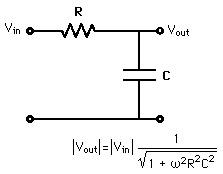
[ Home | Staff & Contacts | HiFi Playground | Listening tests | DIY& Tweakings | Music & Books ]
Author: Roger McCuaig - TNT Canada
Published: May, 2017
As I worked on the TNT AirCoil DIY Interconnect write up I did a lot of thinking and reading around the question of how the capacitance affects frequency response and how low does the interconnect capacitance really have to be. This is the result of that reflection.
For the purposes of analyzing the frequency response an interconnect circuit can be modelled as a Resistance-Capacitance (RC) low pass filter. The resistance of the cable is negligible compared to the resistance of the source so R becomes the source resistance and C is the capacitance of the interconnect cable.

A low pass filter produces a phase shift due to the charging of the capacitance in the circuit and this phase displacement of the signal is dependent on the frequency. Some claim that this will cause smearing of the sound. However, if one does the math, the actual real life delays that could be encountered at 15 kHz are a few microseconds! Can anyone hear that? In his book, Philip Giddings states that “Some research shows that the human ear is quite insensitive to variations in phase.”
An interconnect cable with a capacitance value that yields a frequency drop off of less than 0.4 dB at 17 kHz probably meets the hearing capability for the vast majority of audiophiles. Using the formula shown above, for a source impedance of 600 ohms (my preamp), in order to attain a frequency roll-off of -0.4 dB or less at 17 kHz an interconnect would require a capacitance value of about 5 nano-Farads or less. If the source impedance is in the range of 100 ohms (which is common), then to get the same performance the cable capacitance would have to be less than or equal to about 9 nano-Farads.
The audiophile zeitgeist dictates that no detail is too small or too insignificant to be neglected in the search for audio nirvana. Manufacturers certainly contribute to this mindset with their competition for the consumer's dollars. But if something is inaudible to most humans why do we need to worry about it? Yes, I know, many people argue that removing information in the music signal above the audible range can affect the signal in the audible spectrum, well if one does the math I am sure that can be illustrated, however the question remains; that effect is very far below the audibility threshold so why care about it?
It turns out that it is quite feasible to build a DIY interconnect with a capacitance of much less than 1.0 nanofarad thus resulting in a flat response to well over 20 kHz. See TNT AirCoil DIY interconnect for more info.
References: Giddings, G.H. Philip, (1990). Audio Systems Design and Installation. Butterworth-Keinemann, Woburn, Ma.
© Copyright 2017 Roger McCuaig - roger@tnt-audio.com - www.tnt-audio.com
[ Home | Staff & Contacts | HiFi Playground | Listening tests | DIY& Tweakings | Music & Books ]